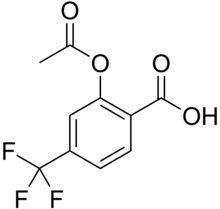Triflusal
 | |
| Clinical data | |
|---|---|
| AHFS/Drugs.com | International Drug Names |
| ATC code | |
| Identifiers | |
| |
JSmol) | |
| |
| |
| | |
Triflusal is a
benzene ring has been replaced by a trifluoromethyl group. Trade names include Disgren, Grendis, Aflen and Triflux.[1]
Triflusal has multiple
platelet aggregation. Additionally, Triflusal preserves vascular prostacyclin which yields an anti-platelet effect. Triflusal also blocks phosphodiesterase, increasing cAMP concentration as well as can increase nitric oxide synthesis in neutrophils
.
Mechanism of action
Triflusal is a selective platelet antiaggregant through;
- blocks platelet aggregation[2]
- preserves vascular prostacyclin, thus promoting anti-aggregant effect[2]
- inhibits activation of platelet aggregation[2]
- blocks phosphodiesterase thereby increasing cAMP concentration, thereby promoting anti-aggregant effect due to inhibition of calcium mobilization [2]
- increases nitric oxide synthesis in neutrophils[2]
Indication
Triflusal is indicated for;
- Prevention of cardiovascular events such as stroke
- Acute treatment of cerebral infarction, myocardial infarction
- Thromboprophylaxis due to atrial fibrillation
Prevention of stroke
In the 2008, guidelines for stroke management from the European Stroke Organization,atherothrombotic stroke. This recommendation was based on the double-blind, randomised TACIP and TAPIRSS trials, which found triflusal to be as effective as Aspirin (acetylsalicylic acid, ASA, which Triflusal is derived from) in preventing post-stroke vascular events, while having a more favourable safety profile.[4][5][6]
Pharmacokinetics
It is absorbed in the
bio-availability ranges from 83% to 100%.[7][8] The active metabolite of Triflusal is 2-hydroxy-4-trifluoromethyl-benzoic acid, which is when Triflusal gets metabolized by an esterase
.
